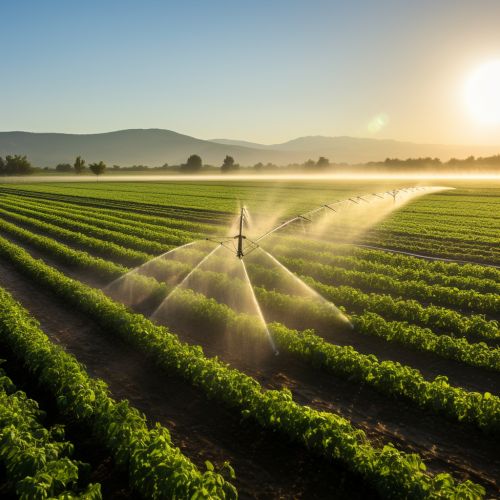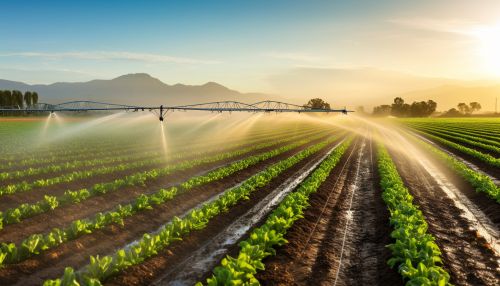Sprinkler irrigation
Overview
Sprinkler irrigation is a method of applying irrigation water which is similar to natural rainfall. Water is distributed through a system of pipes usually by pumping. It is then sprayed into the air through sprinklers so that it breaks up into small water drops which fall to the ground. The system is adaptable to nearly all irrigable soils since sprinklers are available in a wide range of discharge capacity.
History
The concept of sprinkler irrigation is not a modern phenomenon. Ancient civilizations, such as the Egyptians, used primitive sprinkler systems. These systems were based on the principle of using a network of canals and manually controlled gates to distribute water. The modern sprinkler system, as we know it today, was developed in the late 19th century.


Types of Sprinkler Irrigation Systems
There are several types of sprinkler irrigation systems. These include:
Traditional Sprinkler Systems
Traditional sprinkler systems are the most common type of sprinkler irrigation system. They consist of a network of pipes, pumps, and sprinklers that distribute water over a large area. The water is sprayed in a circular pattern, similar to rain.
Drip Irrigation Systems
Drip irrigation systems, also known as trickle irrigation, deliver water directly to the root zone of a plant. This type of system is highly efficient as it minimizes evaporation and runoff.
Center Pivot Irrigation Systems
Center pivot irrigation systems are a type of overhead sprinkler system where equipment rotates around a pivot and crops are watered with sprinklers. These systems are highly efficient and can be automated for ease of use.
Lateral Move Irrigation Systems
Lateral move irrigation systems, also known as linear move, wheelmove or side-roll irrigation, are a type of sprinkler system that moves in a linear direction across the field. Water is supplied by a hose dragged behind the system, or by a self-contained water source.
Components of a Sprinkler Irrigation System
A typical sprinkler irrigation system consists of several key components. These include:
Pump Unit
The pump unit is the heart of the sprinkler irrigation system. It is responsible for drawing water from the source and distributing it through the system. The pump must be powerful enough to deliver the required amount of water and overcome the pressure losses in the pipelines and the sprinklers.
Pipelines
Pipelines, both main and sub-main, are used to transport water from the pump to the sprinklers. They can be made from a variety of materials, including PVC, aluminum, and polyethylene.
Sprinklers
Sprinklers are devices that spray water in a controlled manner. They can be fixed or rotating, and they can cover a small or large area, depending on the requirements of the irrigation system.
Valves
Valves are used to control the flow of water in the sprinkler irrigation system. They can be manual or automatic, and they can be used to isolate sections of the system for maintenance or repair.
Filters
Filters are used to remove debris from the water before it reaches the sprinklers. This prevents the sprinklers from being clogged and ensures a uniform distribution of water.
Advantages and Disadvantages of Sprinkler Irrigation
Like any other irrigation method, sprinkler irrigation has its advantages and disadvantages.
Advantages
- Sprinkler irrigation can be used on uneven land where other methods of irrigation would be ineffective.
- It can be used for almost any type of crop, and it is particularly well-suited for delicate crops that could be damaged by more forceful methods of irrigation.
- Sprinkler systems can be automated, which can save labor and time.
- The system can be used for frost protection and crop cooling.
Disadvantages
- Sprinkler irrigation systems can be expensive to install and maintain.
- Some water is lost to evaporation, especially in hot and windy conditions.
- Overhead sprinklers can encourage the growth of certain types of fungi.
- Sprinkler systems require a significant amount of energy to pump the water.
Environmental Impact
The environmental impact of sprinkler irrigation is a topic of ongoing research. While the method can contribute to the conservation of water by delivering it directly to the root zone of plants, it can also lead to water loss through evaporation and runoff. Additionally, the energy required to pump the water can contribute to greenhouse gas emissions.
Future Trends
With advancements in technology, sprinkler irrigation systems are becoming more efficient and sustainable. Innovations include the use of solar power to pump water, the development of more efficient sprinklers and nozzles, and the use of smart technology to monitor soil moisture levels and automate irrigation schedules.
